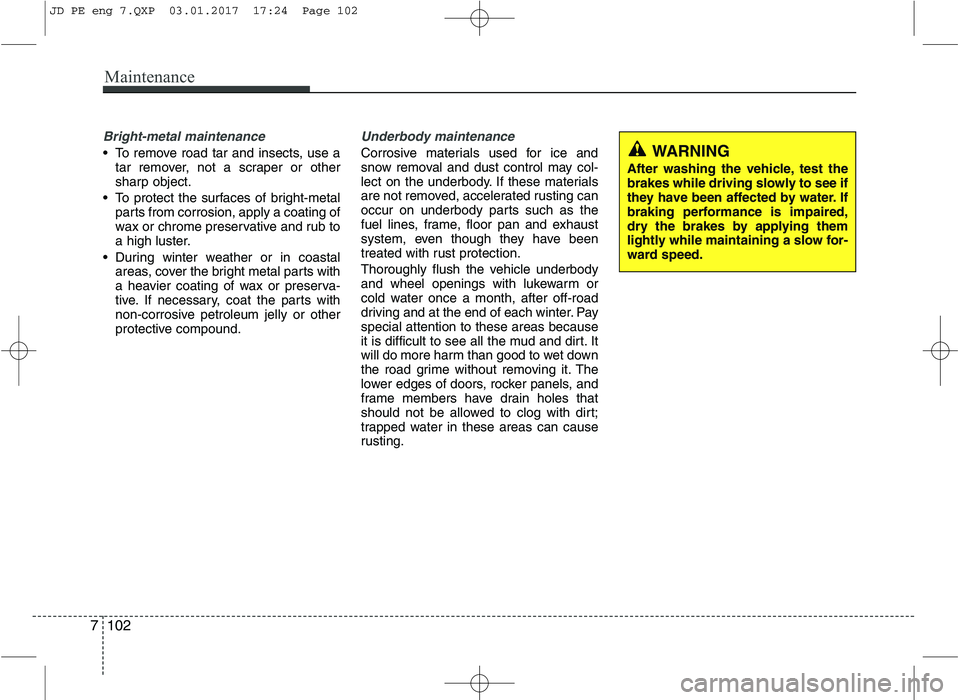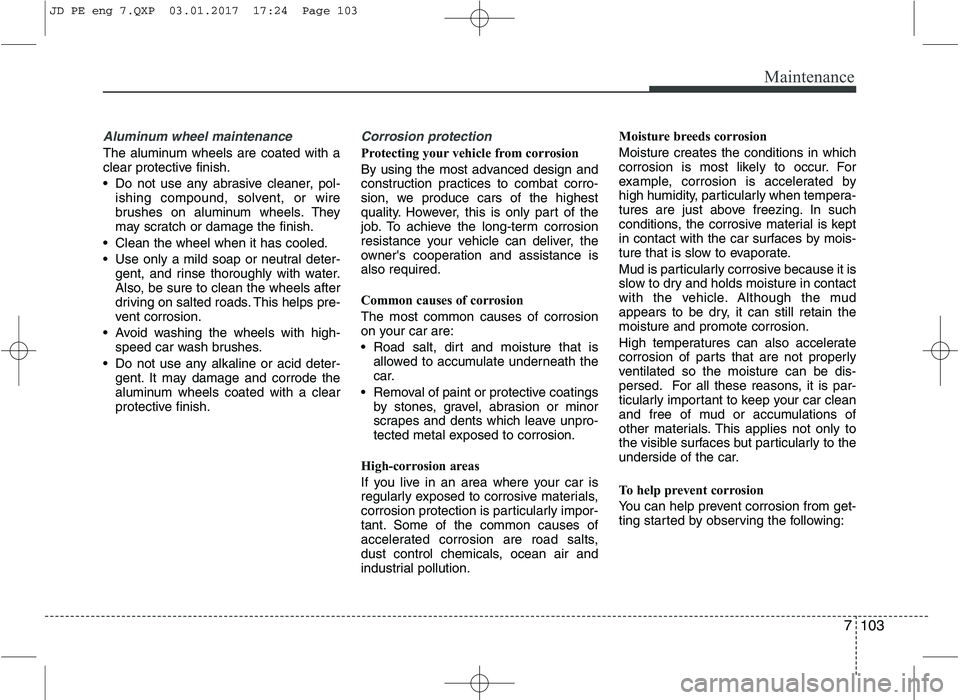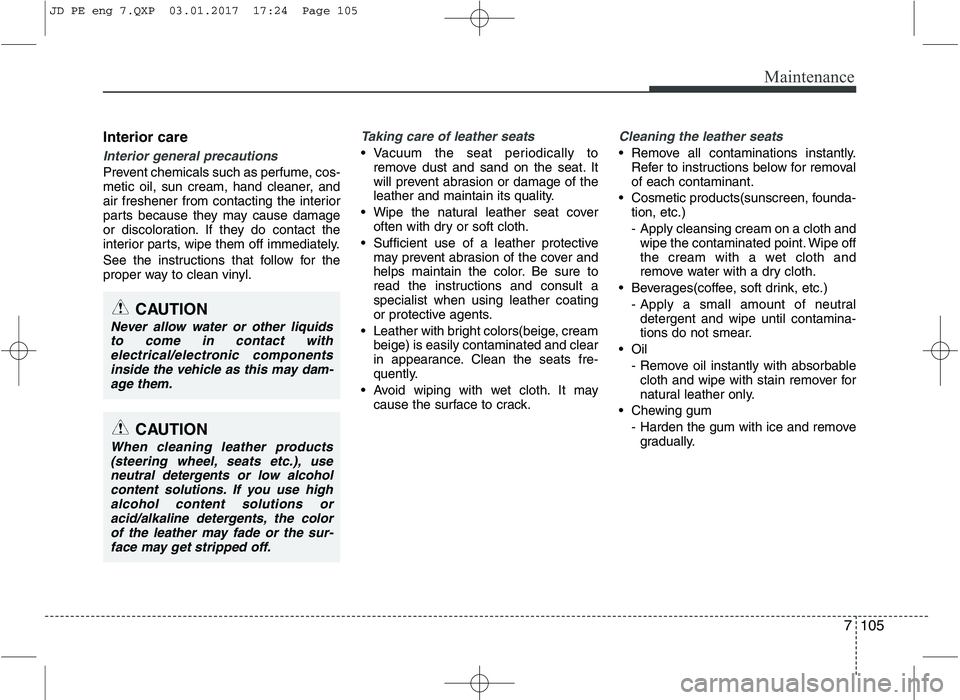2017 KIA CEED wheel
[x] Cancel search: wheelPage 620 of 653

Maintenance
102
7
Bright-metal maintenance
To remove road tar and insects, use a
tar remover, not a scraper or other
sharp object.
To protect the surfaces of bright-metal parts from corrosion, apply a coating of
wax or chrome preservative and rub to
a high luster.
During winter weather or in coastal areas, cover the bright metal parts with
a heavier coating of wax or preserva-
tive. If necessary, coat the parts with
non-corrosive petroleum jelly or other
protective compound.
Underbody maintenance
Corrosive materials used for ice and
snow removal and dust control may col-
lect on the underbody. If these materials
are not removed, accelerated rusting can
occur on underbody parts such as the
fuel lines, frame, floor pan and exhaust
system, even though they have been
treated with rust protection.
Thoroughly flush the vehicle underbody
and wheel openings with lukewarm or
cold water once a month, after off-road
driving and at the end of each winter. Payspecial attention to these areas because
it is difficult to see all the mud and dirt. It
will do more harm than good to wet down
the road grime without removing it. The
lower edges of doors, rocker panels, and
frame members have drain holes that
should not be allowed to clog with dirt;
trapped water in these areas can cause
rusting.WARNING
After washing the vehicle, test the
brakes while driving slowly to see if
they have been affected by water. If
braking performance is impaired,
dry the brakes by applying them
lightly while maintaining a slow for-
ward speed.
JD PE eng 7.QXP 03.01.2017 17:24 Page 102
Page 621 of 653

7103
Maintenance
Aluminum wheel maintenance
The aluminum wheels are coated with a
clear protective finish.
Do not use any abrasive cleaner, pol-ishing compound, solvent, or wire
brushes on aluminum wheels. They
may scratch or damage the finish.
Clean the wheel when it has cooled.
Use only a mild soap or neutral deter- gent, and rinse thoroughly with water.
Also, be sure to clean the wheels after
driving on salted roads. This helps pre-
vent corrosion.
Avoid washing the wheels with high- speed car wash brushes.
Do not use any alkaline or acid deter- gent. It may damage and corrode the
aluminum wheels coated with a clear
protective finish.
Corrosion protection
Protecting your vehicle from corrosion
By using the most advanced design and
construction practices to combat corro-
sion, we produce cars of the highest
quality. However, this is only part of the
job. To achieve the long-term corrosion
resistance your vehicle can deliver, the
owner's cooperation and assistance isalso required.
Common causes of corrosion The most common causes of corrosion
on your car are:
allowed to accumulate underneath the
car.
Removal of paint or protective coatings by stones, gravel, abrasion or minor
scrapes and dents which leave unpro-
tected metal exposed to corrosion.
High-corrosion areas
If you live in an area where your car is
regularly exposed to corrosive materials,
corrosion protection is particularly impor-
tant. Some of the common causes of
accelerated corrosion are road salts,
dust control chemicals, ocean air and
industrial pollution. Moisture breeds corrosion Moisture creates the conditions in which
corrosion is most likely to occur. For
example, corrosion is accelerated by
high humidity, particularly when tempera-
tures are just above freezing. In such
conditions, the corrosive material is kept
in contact with the car surfaces by mois-
ture that is slow to evaporate.
Mud is particularly corrosive because it is
slow to dry and holds moisture in contact
with the vehicle. Although the mud
appears to be dry, it can still retain themoisture and promote corrosion.
High temperatures can also accelerate
corrosion of parts that are not properly
ventilated so the moisture can be dis-
persed. For all these reasons, it is par-
ticularly important to keep your car clean
and free of mud or accumulations of
other materials. This applies not only to
the visible surfaces but particularly to the
underside of the car.
To help prevent corrosion
You can help prevent corrosion from get-
ting started by observing the following:
JD PE eng 7.QXP 03.01.2017 17:24 Page 103
Page 623 of 653

7105
Maintenance
Interior care
Interior general precautions
Prevent chemicals such as perfume, cos-
metic oil, sun cream, hand cleaner, and
air freshener from contacting the interior
parts because they may cause damage
or discoloration. If they do contact the
interior parts, wipe them off immediately.
See the instructions that follow for the
proper way to clean vinyl.
Taking care of leather seats
Vacuum the seat periodically toremove dust and sand on the seat. It
will prevent abrasion or damage of the
leather and maintain its quality.
Wipe the natural leather seat cover often with dry or soft cloth.
Sufficient use of a leather protective may prevent abrasion of the cover and
helps maintain the color. Be sure to
read the instructions and consult aspecialist when using leather coating
or protective agents.
Leather with bright colors(beige, cream beige) is easily contaminated and clear
in appearance. Clean the seats fre-
quently.
Avoid wiping with wet cloth. It may cause the surface to crack.
Cleaning the leather seats
Remove all contaminations instantly.
Refer to instructions below for removal of each contaminant.
Cosmetic products(sunscreen, founda- tion, etc.)
- Apply cleansing cream on a cloth andwipe the contaminated point. Wipe off
the cream with a wet cloth and
remove water with a dry cloth.
Beverages(coffee, soft drink, etc.) - Apply a small amount of neutraldetergent and wipe until contamina-
tions do not smear.
- Remove oil instantly with absorbablecloth and wipe with stain remover for
natural leather only.
Chewing gum - Harden the gum with ice and removegradually.
CAUTION
Never allow water or other liquids
to come in contact with
electrical/electronic componentsinside the vehicle as this may dam-age them.
CAUTION
When cleaning leather products(steering wheel, seats etc.), use neutral detergents or low alcohol
content solutions. If you use highalcohol content solutions oracid/alkaline detergents, the colorof the leather may fade or the sur-
face may get stripped off.
JD PE eng 7.QXP 03.01.2017 17:24 Page 105
Page 629 of 653

Specifications & Consumer information
Dimensions . . . . . . . . . . . . . . . . . . . . . . . . . . . . . . . . 8-2
Engine . . . . . . . . . . . . . . . . . . . . . . . . . . . . . . . . . . . . 8-3
Air conditioning system . . . . . . . . . . . . . . . . . . . . . . 8-4
Gross vehicle weight . . . . . . . . . . . . . . . . . . . . . . . . 8-5
Luggage volume . . . . . . . . . . . . . . . . . . . . . . . . . . . . 8-5
Bulb wattage . . . . . . . . . . . . . . . . . . . . . . . . . . . . . . . 8-6
Tires and wheels . . . . . . . . . . . . . . . . . . . . . . . . . . . . 8-8
Recommended lubricants and capacities . . . . . . . 8-9 Recommended SAE viscosity number . . . . . . . . . . . . 8-12
Vehicle identification number (VIN) . . . . . . . . . . . 8-13
Vehicle certification label . . . . . . . . . . . . . . . . . . . . 8-13
Tire specification and pressure label . . . . . . . . . . . 8-14
Engine number . . . . . . . . . . . . . . . . . . . . . . . . . . . . . 8-14
Air conditioner compressor label . . . . . . . . . . . . . . 8-15
Refrigerant label . . . . . . . . . . . . . . . . . . . . . . . . . . . 8-15
Declaration of conformity . . . . . . . . . . . . . . . . . . . . 8-15
8
Page 630 of 653

Specifications & Consumer information
2
8
DIMENSIONS
Itemmm (in)
3 Door 5 DoorWagon
Overall length4,310 (169.7)4,310 (169.7)4,505 (177.4)
Overall width1,780 (70.1)
2,035 (80.1) * 11,780 (70.1)
2,035 (80.1) * 11,780 (70.1)
2,035 (80.1) * 1
Overall height Except Russia1,430 (56.3)
1,425 (56.1) * 21,470 (57.9)
1,465 (57.7) * 21,485 (58.5)
1,480 (58.3) * 2
For Russia1,440 (56.7)1,480 (58.3)1,495 (58.9)
Front tread
195/65R15Steel wheel1,563 (61.5)1,563 (61.5)1,563 (61.5)
205/55R16Steel wheel1,553 (61.1)1,553 (61.1)1,553 (61.1)
Aluminum wheel1,555 (61.2)1,555 (61.2)1,555 (61.2)
225/45R17Aluminum wheel1,549 (61.0)1,549 (61.0)1,549 (61.0)
225/40R18Aluminum wheel1,545 (60.8)1,545 (60.8)-
Rear tread
195/65R15Steel wheel1,571 (61.9)1,571 (61.9)1,571 (61.9)
205/55R16Steel wheel1,561 (61.5)1,561 (61.5)1,561 (61.5)
Aluminum wheel1,563 (61.5)1,563 (61.5)1,563 (61.5)
225/45R17Aluminum wheel1,557 (61.3)1,557 (61.3)1,557 (61.3)
225/40ZR18Aluminum wheel1,553 (61.1)1,553 (61.1)-
Wheelbase2,650 (104.3)
*
1
: Width including outside mirrors (except T-GDI engine)
* 2
: Emission Package
Page 636 of 653

Specifications & Consumer information
8
8
TIRES AND WHEELS * 1
: Load Index
* 2
: Speed Symbol
* 3
: For 1.0 T-GDI Low Power Engine
ItemTire sizeWheel
sizeLoad CapacitySpeed capacityInflation pressure bar(psi, kPa)Wheel lug nuttorque Kgf·m (lbf·ft, N·m)
Normal loadMaximum load
LI * 1KgSS * 2Km/hFrontRear FrontRear
Full size
tire
195/65R15 * 36.0J×15 91615H2102.5
(36,250)2.5
(36,250)2.5
(36,250)2.5
(36,250)
9~11
(65~79, 88~107)
195/65R156.0J×1591615H2102.5
(36,250)2.5
(36,250)2.5
(36,250)2.5
(36,250)
205/55R166.5J×16 91615H2102.2
(32,220)2.2
(32,220)2.2
(32,220)2.2
(32,220)
225/45R177.0J×1791615V2402.2
(32,220)2.2
(32,220)2.2
(32,220)2.2
(32,220)
225/45R17
(Sports pack)7.0J×1791615V2402.35
(34,235)2.35
(34,235)2.35
(34,235)2.35
(34,235)
225/40ZR187.5J×1892630Y3002.35
(34,235)2.35
(34,235)2.35
(34,235)2.35
(34,235)
Compact
spare tireT125/80D154.0T×1595690M1304.2
(60, 420)4.2
(60, 420)4.2
(60, 420)4.2
(60, 420)
T125/80D164.0T×1697730M1304.2
(60, 420)4.2
(60, 420)4.2
(60, 420)4.2
(60, 420)
✽✽ NOTICE
We recommend that when replacing tires, use the same originally supplied with the vehicles.
If not, that affects driving performance.
When driving in high altitude grades, it is natural for the atmospheric pressure to dec rease. Therefore, please check the tire
pressure and add more air when necessary.
Additionally required tire air pressure per km above sea level: 1.5psi/km
Page 645 of 653

Index
2
I
Active ECO system ......................................................5-39
Active ECO operation ................................................5-39
Limitation of Active ECO operation ..........................5-39
When Active ECO is activated ..................................5-39
Air bag - supplemental restraint system ........................3-43 Additional safety precautions ....................................3-65
Air bag warning and indicator ....................................3-46
Air bag warning label ................................................3-66
Curtain air bag ............................................................3-57
Driver's and passenger's front air bag ........................3-51
How does the air bag system operate ........................3-44
Side impact air bag ....................................................3-56
SRS Care ....................................................................3-64
SRS components and functions ..................................3-48
Air cleaner ....................................................................7-35 Filter replacement ......................................................7-35
Air conditioner compressor label ..................................8-15
Air conditioning system ..................................................8-4
Appearance care ..........................................................7-100 Exterior care ..............................................................7-100
Interior care ..............................................................7-105
Audio System ..............................................................4-185 Antenna ....................................................................4-185
AUX, USB and iPod ®
port ......................................4-187
Steering wheel audio controls ..................................4-186 Automatic climate control system ..............................4-149
Automatic heating and air conditioning ..................4-150
Checking the amount of air conditioner refrigerant and compressor lubricant ..............................................4-160
Climate control air filter ..........................................4-157
Manual heating and air conditioning ........................4-152
System operation ......................................................4-157
Automatic transaxle ......................................................5-23 Automatic transaxle operation ....................................5-23
Good driving practices ................................................5-28
Battery............................................................................7-42 Battery capacity label..................................................7-43
Battery recharging ......................................................7-43
For best battery service ..............................................7-42
Reset items ..................................................................7-44
Before driving ..................................................................5-4 Before entering vehicle ................................................5-4
Before starting ..............................................................5-4
Necessary inspections ..................................................5-4
Blind Spot Detection system (BSD)..............................5-74 BSD (Blind Spot Detection)/LCA (Lane Change Assist) ......................................5-74
Driver’s Attention ......................................................5-80
RCTA (Rear cross traffic alert) ..................................5-78
A
B
Page 647 of 653

Index
4
I
Engine coolant ..............................................................7-29
Changing the coolant ..................................................7-31
Checking the coolant level..........................................7-29
Engine number ..............................................................8-14
Engine oil ......................................................................7-27 Changing the engine oil and filter ..............................7-28
Checking the engine oil level ....................................7-27
Engine start/stop button ..................................................5-9 Engine start/stop button position ..................................5-9
Illuminated engine start/stop button ............................5-9
Starting the engine ......................................................5-12
Explanation of scheduled maintenance items ..............7-24
Exterior features ..........................................................4-182 Mounting bracket for roof carrier ............................4-182
Roof rack ..................................................................4-183
Exterior overview (Front) ................................................2-2
Exterior overview (Rear) ................................................2-3
Fuel filler lid ..................................................................4-31 Closing the fuel filler lid ............................................4-31
Opening the fuel filler lid ..........................................4-31
Fuel filter (for Diesel)....................................................7-34 Draining water from fuel filter ..................................7-34
Fuel requirements ............................................................1-2 Diesel engine ................................................................1-4
Gasoline engine ............................................................1-2 Fuses ..............................................................................7-56
Fuse/relay panel description ......................................7-61
Gross vehicle weight ......................................................8-5
Hazard warning flasher................................................4-120
Hood ..............................................................................4-29 Closing the hood ........................................................4-30
Opening the hood ........................................................4-29
How to use this manual ..................................................1-2
If the engine overheats ....................................................6-8
If the engine will not start ..............................................6-4 If engine doesn’t turn over or turns over slowly ..........6-4
If engine turns over normally but does not start ..........6-4
If you have a flat tire (with spare tire) ............................6-9 Changing tires ............................................................6-10
EC Declaration of Conformity for Jack......................6-18
Jack and tools ................................................................6-9
Jack label ....................................................................6-17
Removing and storing the spare tire ..........................6-10
Wheel nut tightening torque ......................................6-14
F
G
H
I